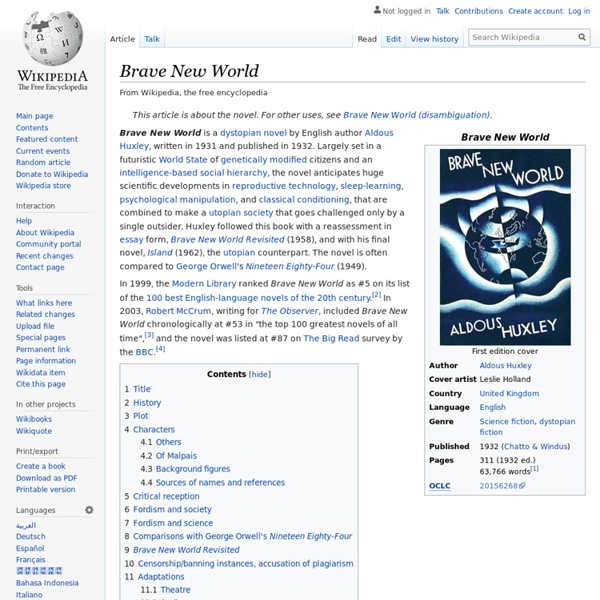H. G. Wells bibliography
H. G. Wells was a prolific writer of both fiction and non-fiction. His writing career spanned more than sixty years, and his early science fiction novels earned him the title (along with Jules Verne and Hugo Gernsback) of "The Father of Science Fiction".[1] Novels[edit] Wells's works were reprinted in American science fiction magazines as late as the 1950s
V for Vendetta
Publication history[edit] When the publishers cancelled Warrior in 1985 (with two completed issues unpublished due to the cancellation), several companies attempted to convince Moore and Lloyd to let them publish and complete the story. In 1988, DC Comics published a ten-issue series that reprinted the Warrior stories in colour, then continued the series to completion. The first new material appeared in issue No. 7, which included the unpublished episodes that would have appeared in Warrior No. 27 and No. 28. Tony Weare drew one chapter ("Vincent") and contributed additional art to two others ("Valerie" and "The Vacation"); Steve Whitaker and Siobhan Dodds worked as colourists on the entire series. Background[edit]
40 Beautiful 8-Bit Artworks
8 Bit Art can refer to a style of synthesized electronic music called “chiptunes”, as well as a form of digital art called “pixel art”. Both chiptunes and Pixel Art can be more than 8-bits. Chiptunes, also referred to as “chip music”, are often made using sound hardware from old video game consoles or computer systems.
The New America: The New World
The New America: The New World is a collection of four articles by H.G. Wells written to examine the American scene, which Wells summed up in 1935 as "the spectacle of a great material civilization, halted, paralyzed.
Nineteen Eighty-Four
History and title[edit] A 1947 draft manuscript of the first page of Nineteen Eighty-Four, showing the editorial development. The Last Man in Europe was an early title for the novel but in a letter dated 22 October 1948 to his publisher Fredric Warburg, eight months before publication, Orwell wrote about hesitating between The Last Man in Europe and Nineteen Eighty-Four.[14] Warburg suggested changing the main title to a more commercial one.[15] Copyright status[edit] The novel will be in the public domain in the European Union and Russia in 2021 and in the United States in 2044.[21] It is already in the public domain in Canada;[22] South Africa,[23] Argentina[24] Australia,[25] and Oman.[26]
The Chicken and the Pig
The Chickens and the Pig The fable of The Chicken and the Pig is about commitment to a project or cause. When producing a dish made of ham and eggs, the pig provides the ham which requires his sacrifice and the chicken provides the eggs which are not difficult to produce. Thus the pig is really committed in that dish while the chicken is only involved, yet both are needed to produce the dish. Content[edit] The fable of the Chicken and the Pig is used to illustrate the differing levels of project stakeholders involved in a project.
The New World Order (Wells)
Jump up ^ Partington, John S. Building Cosmopolis: The Political Thought of H.G. Wells.
Waiting for Godot
Plot[edit] Act I[edit] Estragon soon dozes off, but, after rousing him, Vladimir is not interested in hearing about Estragon's dreams—another recurring motif. Estragon wants to hear an old joke, which Vladimir starts but cannot finish, as he is urgently compelled to rush off and urinate due to a kidney ailment that pains him whenever he laughs. Estragon next suggests that they hang themselves, but they abandon the idea when their strategy seems infeasible. Estragon asks what Godot is going to do for them once he arrives, but "Oh ... nothing very definite" is the best that Vladimir can manage.[7] When Estragon declares that he is hungry, Vladimir provides a carrot (among a collection of turnips), at which Estragon idly gnaws, loudly reiterating their boredom.
Life & Style / Metroplus : Mission heritage
It certainly makes for an interesting travelogue when two Indian youngsters who have lived the good life and visited exotic places around the world decide to rough it out for three months, travelling in rickety old buses to tourist spots across India. But Aniketh MJ and Sulesh Kumar — both 24, from Bengaluru — have also turned their adventure into an attempt at raising awareness about 28 UNESCO World Heritage Sites in India. As they travel, Aniketh and Sulesh will assess these heritage sites and pass on their findings to UNESCO.
Dracula 1897, Boards the Demeter bound for England.
1897 Gothic horror novel by Irish author Bram Stoker Dracula is an 1897 Gothic horror novel by Irish author Bram Stoker. It introduced the character of Count Dracula and established many conventions of subsequent vampire fantasy.[1] The novel tells the story of Dracula's attempt to move from Transylvania to England so that he may find new blood and spread the undead curse, and of the battle between Dracula and a small group of people led by Professor Abraham Van Helsing.
The Great Gatsby
Fitzgerald—inspired by the parties he had attended while visiting Long Island's north shore—began planning the novel in 1923, desiring to produce, in his words, "something new—something extraordinary and beautiful and simple and intricately patterned."[3] Progress was slow, with Fitzgerald completing his first draft following a move to the French Riviera in 1924. His editor, Maxwell Perkins, felt the book was too vague and convinced the author to revise over the next winter. Fitzgerald was ambivalent about the book's title, at various times wishing to re-title the novel Trimalchio in West Egg.
The greatest program ever written
David Horne is not an urban myth. David Horne achieved what many would even now consider impossible. He wrote a chess game, with AI, that ran on a poorly documented, buggy machine that contained only 1k of memory. The Sinclar ZX81. Think about that amount of memory for a moment. 1 kilobyte. 1024 bytes. Can you write down the rules of chess in less than one thousand characters?



